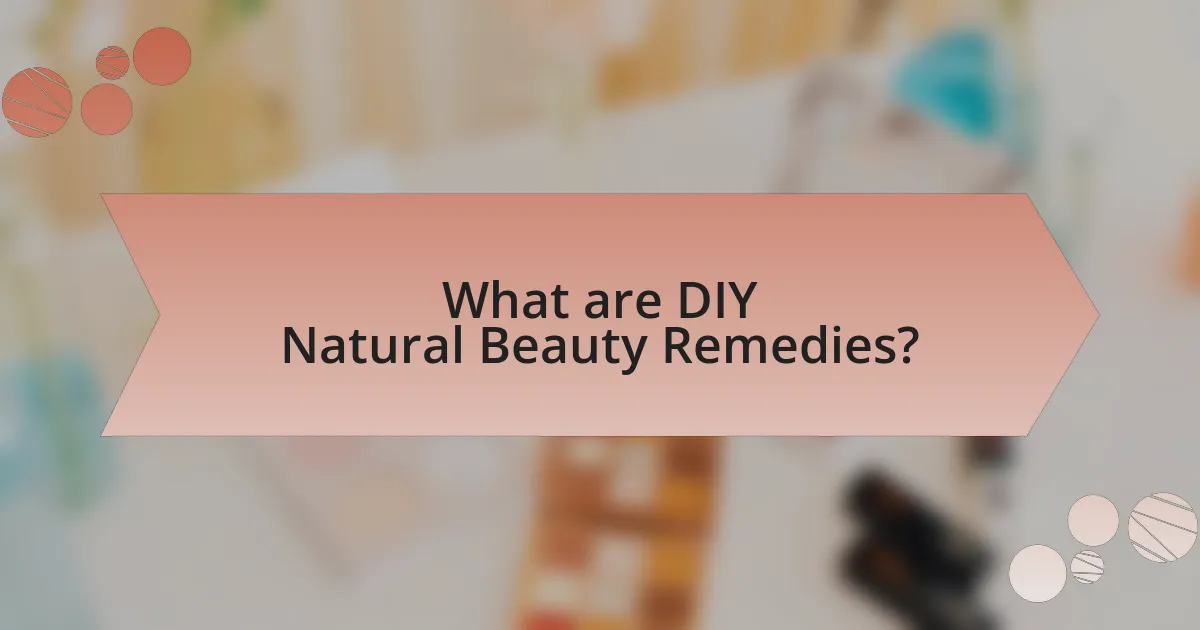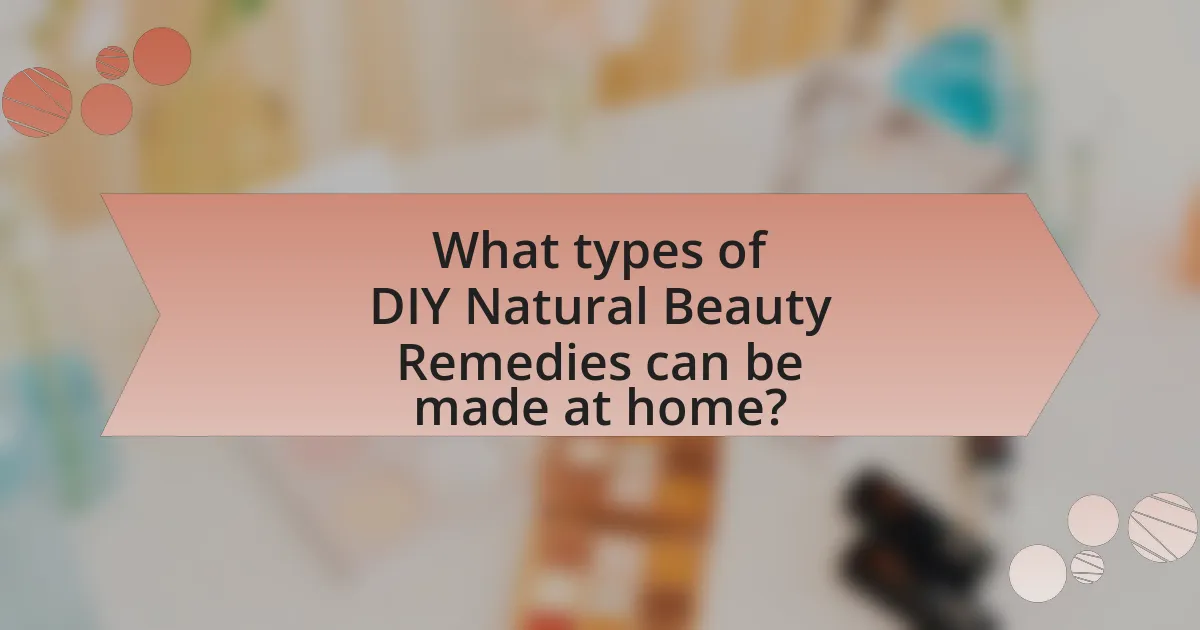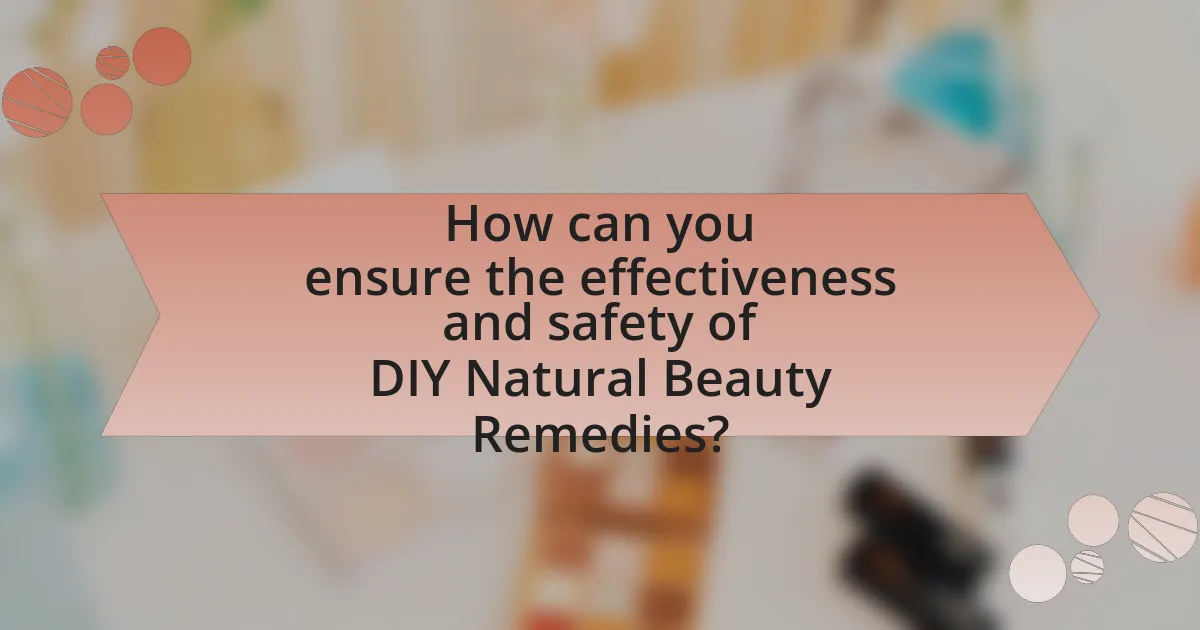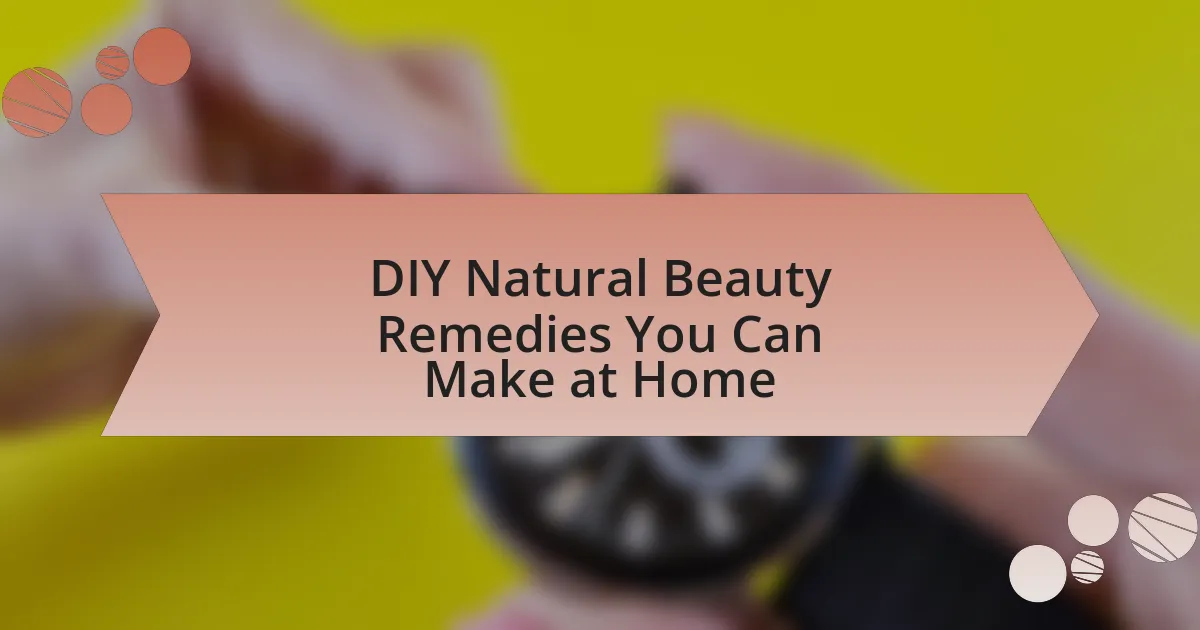DIY natural beauty remedies are homemade treatments that utilize natural ingredients such as honey, coconut oil, and essential oils to enhance beauty and skincare. These remedies differ from commercial products by using unprocessed ingredients tailored to individual skin types, often avoiding harmful additives found in synthetic products. The article explores common ingredients, their benefits, and how to create effective DIY remedies for skin and hair health, while also addressing safety precautions, cost savings, and customization options. Additionally, it provides practical tips for ensuring the effectiveness of these natural treatments and highlights the importance of using high-quality ingredients.

What are DIY Natural Beauty Remedies?
DIY natural beauty remedies are homemade treatments that utilize natural ingredients to enhance beauty and skincare. These remedies often include items like honey, coconut oil, and essential oils, which are known for their beneficial properties. For example, honey is a natural moisturizer and has antibacterial qualities, making it effective for skin hydration and acne treatment. Studies have shown that natural ingredients can be as effective as commercial products, often without the harsh chemicals.
How do DIY Natural Beauty Remedies differ from commercial products?
DIY natural beauty remedies differ from commercial products primarily in their ingredients and formulation processes. DIY remedies typically utilize natural, unprocessed ingredients such as fruits, oils, and herbs, which can be tailored to individual skin types and preferences. In contrast, commercial products often contain synthetic chemicals, preservatives, and fragrances designed for mass production and longer shelf life.
Research indicates that many commercial beauty products can include harmful additives, while DIY remedies can be free from these chemicals, offering a more personalized and potentially safer alternative. For example, a study published in the Journal of Cosmetic Science highlights that natural ingredients like aloe vera and coconut oil can provide effective moisturizing benefits without the side effects associated with synthetic compounds.
What ingredients are commonly used in DIY Natural Beauty Remedies?
Common ingredients used in DIY natural beauty remedies include coconut oil, honey, aloe vera, shea butter, and essential oils. Coconut oil serves as a moisturizer and has antibacterial properties, while honey is known for its humectant qualities and ability to soothe skin. Aloe vera is often utilized for its healing properties and ability to hydrate. Shea butter is rich in vitamins and provides deep moisture, and essential oils like lavender or tea tree oil are frequently added for their aromatic and therapeutic benefits. These ingredients are widely recognized for their effectiveness in enhancing skin and hair health.
Why are natural ingredients preferred in beauty remedies?
Natural ingredients are preferred in beauty remedies due to their safety, effectiveness, and minimal side effects. Many consumers seek alternatives to synthetic chemicals, which can cause irritation or allergic reactions; for instance, a study published in the Journal of Dermatological Science found that natural ingredients like aloe vera and coconut oil are less likely to provoke skin sensitivities compared to synthetic compounds. Additionally, natural ingredients often contain beneficial nutrients, such as vitamins and antioxidants, which can enhance skin health and appearance, further supporting their popularity in DIY beauty remedies.
What are the benefits of using DIY Natural Beauty Remedies?
DIY natural beauty remedies offer several benefits, including cost-effectiveness, customization, and the use of natural ingredients. These remedies typically utilize common household items, significantly reducing expenses compared to commercial beauty products. Customization allows individuals to tailor remedies to their specific skin types and concerns, enhancing effectiveness. Furthermore, many natural ingredients, such as honey and coconut oil, possess beneficial properties like antibacterial and moisturizing effects, which are supported by studies indicating their efficacy in skincare. For example, honey has been shown to have antimicrobial properties, making it effective for acne treatment.
How can DIY remedies improve skin health?
DIY remedies can improve skin health by utilizing natural ingredients that provide essential nutrients, hydration, and healing properties. For instance, ingredients like honey possess antibacterial and moisturizing qualities, while aloe vera is known for its soothing and anti-inflammatory effects. Studies have shown that natural oils, such as coconut oil, can enhance skin barrier function and reduce moisture loss. Additionally, DIY masks made from fruits like avocado and banana can deliver vitamins and antioxidants directly to the skin, promoting a healthier complexion. These remedies often avoid harsh chemicals found in commercial products, reducing the risk of irritation and allergic reactions.
What cost savings can be achieved with DIY remedies?
DIY remedies can achieve significant cost savings, often reducing expenses by 50% to 90% compared to store-bought products. For example, a homemade face mask using ingredients like honey and oatmeal can cost less than $2, while a similar commercial product may retail for $20 or more. Additionally, creating your own hair treatments or scrubs allows for customization and eliminates the markup associated with branding and packaging, further enhancing savings. Studies indicate that consumers can save hundreds of dollars annually by opting for DIY solutions instead of purchasing pre-made beauty products.

What types of DIY Natural Beauty Remedies can be made at home?
DIY natural beauty remedies that can be made at home include facial masks, scrubs, hair treatments, and moisturizers. For example, a common facial mask can be created using honey and oatmeal, which are known for their moisturizing and exfoliating properties. Scrubs can be made from sugar or coffee grounds mixed with oils, providing effective exfoliation and skin rejuvenation. Hair treatments often involve ingredients like coconut oil or avocado, which nourish and strengthen hair. Additionally, homemade moisturizers can be crafted using shea butter or aloe vera, both recognized for their hydrating benefits. These remedies utilize readily available ingredients and are supported by traditional practices in natural skincare.
How can you create homemade facial masks?
To create homemade facial masks, combine natural ingredients that suit your skin type and desired outcome. For example, mix honey and yogurt for hydration, or combine mashed avocado and olive oil for nourishment. These ingredients are known for their beneficial properties; honey has antibacterial qualities, while yogurt contains lactic acid that exfoliates the skin. Additionally, using ingredients like oatmeal can soothe irritation, making it a versatile option for various skin concerns.
What ingredients are effective for different skin types?
For oily skin, ingredients like salicylic acid and tea tree oil are effective as they help control excess oil and reduce acne. Salicylic acid penetrates pores to clear out excess sebum and dead skin cells, while tea tree oil has antibacterial properties that combat acne-causing bacteria. For dry skin, hyaluronic acid and glycerin are beneficial because they attract moisture and hydrate the skin. Hyaluronic acid can hold up to 1,000 times its weight in water, making it a powerful humectant. For sensitive skin, soothing ingredients such as aloe vera and chamomile are effective; aloe vera has anti-inflammatory properties that calm irritation, and chamomile is known for its ability to reduce redness and soothe the skin. Lastly, for combination skin, a balanced approach using ingredients like niacinamide and jojoba oil works well; niacinamide helps regulate oil production and improve skin texture, while jojoba oil mimics the skin’s natural sebum, providing hydration without clogging pores.
How do you apply and remove facial masks safely?
To apply and remove facial masks safely, first cleanse your face thoroughly to remove dirt and oils, ensuring the mask adheres properly. When applying the mask, use clean fingers or a brush to spread an even layer over your face, avoiding the eye area. Leave the mask on for the recommended time, usually between 10 to 30 minutes, depending on the ingredients. To remove the mask, gently rinse with lukewarm water, using a soft cloth if necessary, and pat your face dry with a clean towel. This method minimizes irritation and ensures that the mask is effectively removed without damaging the skin.
What are some effective DIY hair treatments?
Effective DIY hair treatments include coconut oil, honey, and avocado masks. Coconut oil deeply moisturizes and reduces protein loss in hair, making it beneficial for dry and damaged strands. Honey acts as a natural humectant, attracting moisture and providing shine, while avocado is rich in vitamins and fatty acids that nourish and strengthen hair. Studies have shown that these natural ingredients can improve hair health and appearance, making them popular choices for at-home treatments.
How can natural oils benefit hair health?
Natural oils can significantly benefit hair health by providing essential nutrients, moisture, and protection. Oils such as coconut, argan, and jojoba are rich in fatty acids and vitamins that nourish the hair and scalp, promoting stronger and shinier hair. For instance, coconut oil has been shown to reduce protein loss in hair, which can lead to less damage and breakage. A study published in the Journal of Cosmetic Science found that coconut oil penetrates the hair shaft more effectively than mineral oil or sunflower oil, enhancing moisture retention. Additionally, natural oils can help soothe the scalp, reduce dandruff, and improve overall hair texture, making them a valuable addition to hair care routines.
What homemade treatments can address common hair issues?
Homemade treatments for common hair issues include using coconut oil for dryness, apple cider vinegar for dandruff, and honey for shine. Coconut oil penetrates the hair shaft, providing moisture and reducing protein loss, which is essential for dry hair. Apple cider vinegar has antifungal properties that help combat dandruff and restore scalp pH balance. Honey acts as a natural humectant, attracting moisture and enhancing hair shine. These treatments are supported by their natural properties and have been used traditionally for effective hair care.

How can you ensure the effectiveness and safety of DIY Natural Beauty Remedies?
To ensure the effectiveness and safety of DIY natural beauty remedies, it is essential to use high-quality, fresh ingredients and follow scientifically-backed recipes. High-quality ingredients, such as organic oils and fresh herbs, contain more active compounds that enhance efficacy and reduce the risk of adverse reactions. Following scientifically-backed recipes ensures that the proportions and combinations of ingredients are safe and effective, as they are often based on traditional knowledge or research findings. For instance, a study published in the Journal of Ethnopharmacology highlights the benefits of using specific plant extracts for skin health, demonstrating that certain natural ingredients can provide measurable results. Additionally, conducting a patch test before applying any remedy to a larger area can help identify potential allergic reactions, further ensuring safety.
What precautions should be taken when using DIY remedies?
When using DIY remedies, it is essential to conduct a patch test to ensure no allergic reactions occur. This precaution helps identify potential skin sensitivities to ingredients before applying them more broadly. Additionally, one should use clean utensils and containers to prevent contamination, as bacteria can compromise the safety and effectiveness of the remedy. It is also important to research each ingredient’s properties and potential side effects, as some natural substances can cause irritation or adverse reactions. Lastly, individuals should avoid using DIY remedies on broken or irritated skin, as this can exacerbate issues and lead to further complications.
How can you test for allergies before using a new remedy?
To test for allergies before using a new remedy, perform a patch test by applying a small amount of the remedy to a discreet area of skin, such as the inner forearm. Wait 24 to 48 hours to observe any adverse reactions, such as redness, itching, or swelling. This method is widely recommended by dermatologists and is a standard practice for assessing skin sensitivity to new products.
What storage tips help maintain the potency of homemade remedies?
To maintain the potency of homemade remedies, store them in airtight containers away from light, heat, and moisture. Airtight containers prevent oxidation and contamination, while exposure to light and heat can degrade active ingredients. For example, essential oils and herbal extracts are best kept in dark glass bottles in a cool, dark place to preserve their efficacy. Additionally, refrigeration can extend the shelf life of certain remedies, such as those containing perishable ingredients.
What are some common mistakes to avoid in DIY Natural Beauty Remedies?
Common mistakes to avoid in DIY natural beauty remedies include using inappropriate ingredients, neglecting patch tests, and failing to follow proper measurements. Using ingredients that are not suitable for skin types can lead to irritation or allergic reactions; for example, citrus oils can cause photosensitivity. Neglecting patch tests can result in adverse reactions, as skin sensitivities vary widely among individuals. Additionally, improper measurements can alter the effectiveness of the remedy, potentially leading to ineffective or harmful results. These mistakes can compromise the safety and efficacy of DIY beauty treatments.
How can incorrect ingredient ratios affect results?
Incorrect ingredient ratios can significantly alter the effectiveness and safety of DIY natural beauty remedies. For instance, using too much of an acidic ingredient, like lemon juice, can lead to skin irritation, while insufficient amounts may not provide the desired exfoliating effect. Research indicates that precise measurements are crucial; a study published in the Journal of Cosmetic Science highlights that formulations with incorrect ratios can result in reduced efficacy and increased risk of adverse reactions. Therefore, maintaining accurate ingredient ratios is essential for achieving the intended results in natural beauty remedies.
What are the risks of using expired ingredients?
Using expired ingredients poses several risks, including reduced effectiveness, potential toxicity, and contamination. Expired ingredients may lose their potency, rendering them ineffective for their intended purpose in beauty remedies. Additionally, some expired ingredients can develop harmful bacteria or mold, leading to skin irritation or infections. For example, oils can go rancid, which not only diminishes their benefits but can also cause adverse reactions when applied to the skin. Therefore, using expired ingredients in DIY natural beauty remedies can compromise both safety and efficacy.
What are some practical tips for creating effective DIY Natural Beauty Remedies?
To create effective DIY natural beauty remedies, start by selecting high-quality, natural ingredients that are known for their beneficial properties, such as coconut oil for moisturizing or honey for its antibacterial effects. Ensure that you research the specific benefits of each ingredient to tailor remedies to your skin type or beauty needs. For example, aloe vera is effective for soothing sunburn, while oatmeal can help with skin irritation.
Additionally, maintain proper hygiene by sterilizing containers and tools to prevent contamination, which is crucial for preserving the effectiveness of your remedies. Mixing ingredients in small batches can also enhance freshness and potency. Lastly, perform a patch test before applying any remedy to your entire face or body to check for allergic reactions, ensuring safety and effectiveness.
